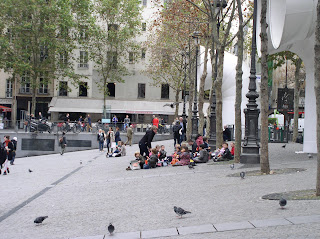The Pompidou Center was conceived in 1969 by Georges Pompidou, President of France from 1969-1974, to bring art and culture to the “man in the street.” It was constructed between 1971-1977.The Pompidou Center is home to the Musee National d’Art Moderne, one of the most comprehensive collections of 20th century modern European art in the world.
The Pompidou Center is a different kind of museum experience, and it is definitely not for those who have a preconceived idea of what a museum should look like. The building is very distinctive. It has been described as "an oil refinery in the center of the city". The colored external piping is a special feature of the building. Air conditioning ducts are blue, water pipes are green and electricity lines are yellow. Escalators are red and the white ducts are ventilation shafts for the underground areas. Even the steel beams that make up the Pompidou Centre's framework are on the outside. The intention of the architects was to place the various utilities outside of the building's framework, thereby allowing for an extra large and uncluttered internal space for the display of art work. They were right, and when you understand the motivation behind the unusual architecture, you can appreciate the huge expanse of internal space it provides for artwork even more.
Approaching the Pompidou Museum from the back
Ventilation shafts for the underground areas
The Igor Stravinsky Fountain isn’t your classical kind of fountain, either. It is more like a large shallow basin which contains 16 modern art sculptures that spout water and continually rotate or move back and forth.. The sculptures were inspired by Stravinsky’s major musical compositions, including “The Rite of Spring.“ If you like modern art done in a whimsical style, you’ll love this fountain. It is located adjacent to the Pompidou Museum.
Rotating musical note sculpture in Stravinsky Fountain
Sculpture in Stravinsky Fountain
Elephant head sculpture in Fountain
Rotating heart sculpture in Fountain
A pair of ruby red lips spouting water in the Fountain
Fantastical animal spouting water from his head
The courtyard in front of the museum and the Atelier Brancusi in the background
A giant mobile in the museum courtyard
A Bulgarian couple playing for tips
A sign for the Edvard Munch exhibit is above them
The Bulgarian couple
Notice the little white puppy nipping at the woman’s ankles.
The lobby of the museum is big and glitzy. It seems that there are neon signs everywhere, except to tell you where to find the art collections
The lobby of the museum

The lobby of the museum
A flashing bulletin board in the lobby
The flashing billboard shows a photo of an art installation, which is a giant mushroom.
After looking at a brochure describing the layout of the museum, I figured out that the main collections are on the fourth, fifth and sixth levels. The sixth level has the special exhibit of Edvard Munch, whose best-known work is probably “The Scream.” I decided to start at the top and work my way down. The escalator, located in its own glass tube ON THE OUTSIDE of the building is the way you gain access to each of the levels. The escalator not only gets you to the top, it also provides breathtaking views of Paris.

A picture of Pompidou
He’s saying that "art must discuss, contest and protest." His photo is above a platform between museum levels

The escalator provides access to each of the levels.
It continues its way to the top.

A small courtyard outside the Brancusi Atelier
It continues its way to the top.
From the top level, you have a bird’s-eye view of Paris.
The escalator between levels from the inside of the glass tube
The platform at the top level from the inside

A view of the Stravinsky Fountain from the top level of the museum escalator
A view of the courtyard from the top level of the museum escalator
A view of the courtyard from the top level of the museum escalator
A view of the Eiffel Tower in the distance
A view of the dome of Sacre Coeur in the distance
The Munch exhibit was very interesting, especially since I didn’t know anything about his artwork besides “The Scream.” I do now. This exhibit lasts until January 2012. From the sixth floor, I went down to the fifth level, where there are collections of modern art, including painting, sculpture and photography, from 1905 to the sixties. The space is huge, and we have the architects who went out on a limb to build this strange, inside-out building to thank for these wide open spaces. Visiting this collection is eye-opening and a lot of fun. You never know what unique, odd, beautiful, ugly or unexpected work of art you are going to come upon next. An example of the odd but beautiful artwork is the giant mushroom on the flashing billboard in the lobby. I didn’t make it down to the f ourth floor, where the Contemporary Collections, from 1960 to the present, are housed. That will be for another day.
The Brancusi Atelier is in a small building to the left of the museum. It is a reconstruction of the artist’s studio, together with some of his abstract sculptures and his tools. It is in a glassed-in area in-the-round, so it seems as if you are viewing the actual studio.
A last look at the escalator as seen from the atelier





























No comments:
Post a Comment